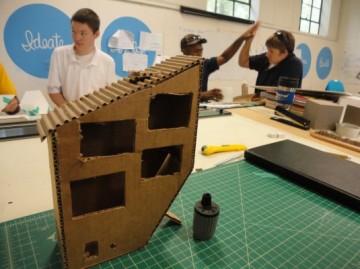Looking back at my high school days, I really enjoyed the times I spent doing community and service projects in rural areas. The phrase ‘community and service’ might sound like a boring term for many, but it reminds me of an eye-opening trip I had when I was 17. At that age, my classmates and I went on a trip to a rural village in China to teach English. And just being away from the city life for a week made me ponder on many issues of life.

My Grade 12 class and the students
“So … some of the students walk for 5 hours to school? What about proper sanitization? How did these students view life?” were some of my thoughts. These memories happen to flood my mind as I work in the Sauder Studio. “Weird.” Yes, I believe that’s what you must be thinking.
Just last week, I was talking about how design thinking plays a part in the business world. But, have you even wondered how design thinking strategies can play a part in rural areas too?
In a place where 27% of 3rd-8th grade students in 2007 were passing English and Math state standards, where 95% of public school students receive free/reduced-rate lunches and where the main economy is agriculture, there lies a school with a design/ build curriculum.
Founded by Emily Pilloton and her partner Matthew Miller, Studio H is a public high school “design/build” curriculum that sparks community development through real-world, built projects. Originally launched in rural Bertie County, North Carolina, Studio H is now based out of Realm Charter School in Berkeley, CA. Studio H teaches students design thinking and hands-on construction skills to build one big public project for local community benefit each year. Every project will be designed and built by students alongside their instructors.
What really stood out to me was Emily Pilloton’s enthusiasm and open-mindedness in teaching the students. “I want it (the project) to come from my students. I want to help them find something they are going to be passionate about,” she says. And just hearing those words, it makes me think of the ‘Desirability’ lens of the IDEO Human-Centred Design (HCD) design process – we focus our solutions on what others desire by seeking to listen and understand their needs.
One of the projects was creating chicken coops. They wanted to have lesser chickens in their backyard as a sustainable food resource, rather than having about 250 000 chickens at one time. And it’s really interesting how Emily Pilloton and Matt Miller delivered their lessons. Pulling a semi truck hood out of the woods and converting it into a makeshift chicken coop so that they could have the chickens in the studio during the project, they told the students to “get to know your clients.”
I can’t help but just make a subtle comparison of my educational journey, where lesson plans and learning outcomes are all already set in place. I am not saying one is better than the other, but getting hands-on is definitely an alternative way of learning.

